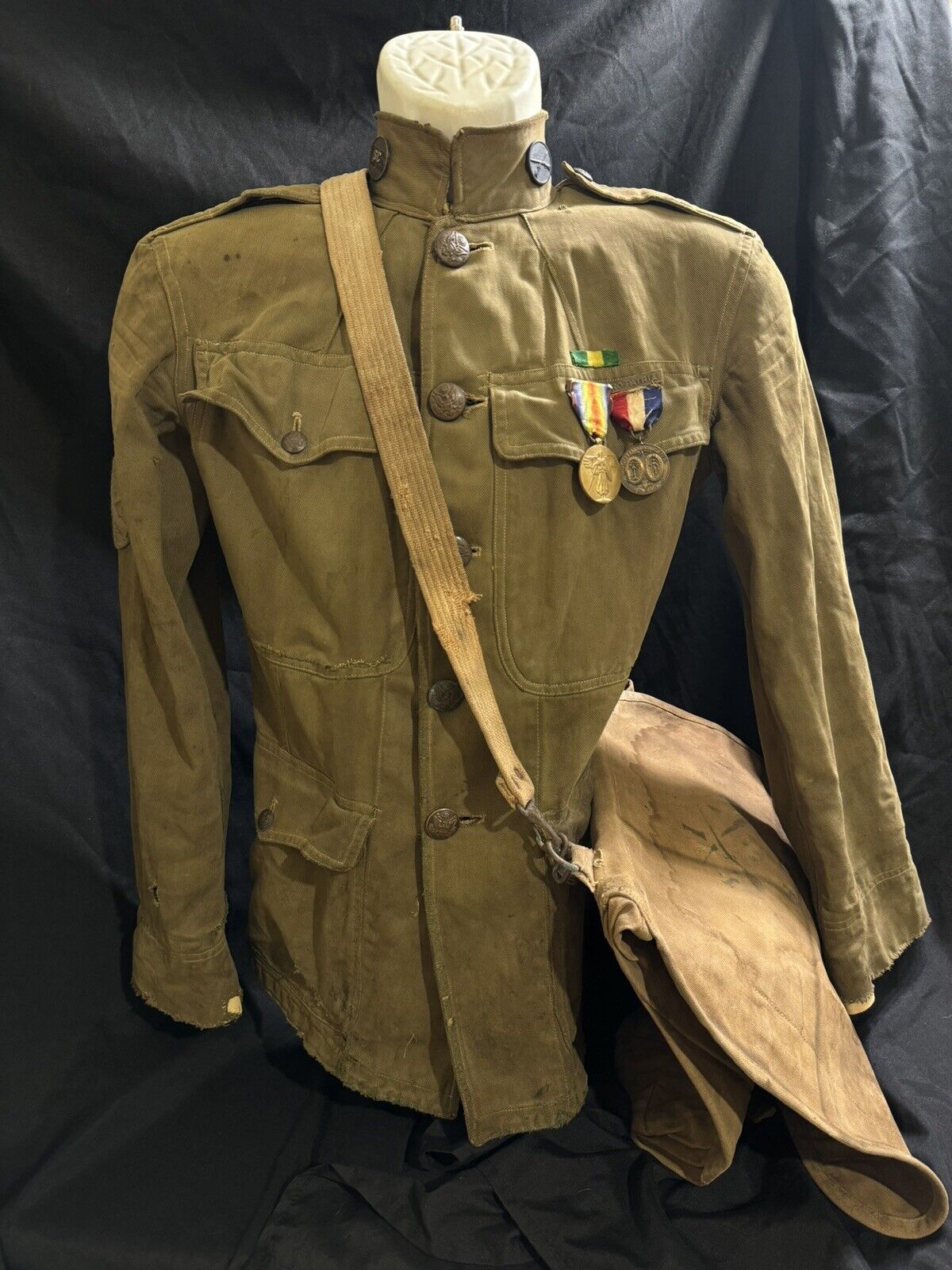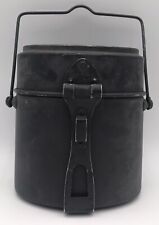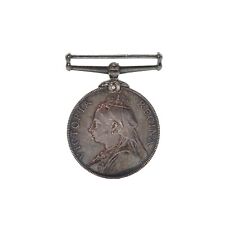When you click on links to various merchants on this site and make a purchase, this can result in this site earning a commission. Affiliate programs and affiliations include, but are not limited to, the eBay Partner Network.
For your consideration is this Pre WWI M1911 Spec 1125 Service Coat for Co A First South Carolina Infantry. (Butler Guard)
This infantry PFC was from Greenville, SC. The Haversack is marked 1st SC Guard the collar disk was made by a jeweler and marked 1st SC the other disk is Infantry.
This is a very early tunic that has rimless buttons.
He has a WWI US medal, WWI Greenville, SC medal, and Mexican Border Service ribbon.
This tunic was in pieces and I did what I had to in order to conserve the piece. There aren’t many Southern tunics from this period and we can let them go to waste.
I had another tunic that had dry rotted but the cuffs were still good and I patched both cuffs at the end of the right & left arm. Plz note this in the pictures above. Thank you.
I have to sell this for my daughter Allison. She has cancer.
We are doing our best to win the fight with Leukemia.
100% of my sales goes to her recovery.
Greenvillians joined “punitive expedition” into Mexico to capture Pancho Villa
Pancho Villa was terrorizing America’s southwest border in 1916.
Company A of the First South Carolina Infantry, Greenvillians all, was sent to help stop him.
A revolutionary hero in his native Chihuahua Province, where he had redistributed hacienda lands among the poor, Villa had invaded the United States because U.S. authorities had recognized his opponent, Carranza, as president of Mexico and had allowed his troops to ride American railroads to attack Villa and his guerrilla forces.
In a series of 38 “incursions” across the border, including one into Columbus, New Mexico, Villa’s “insurgents” stole horses, artillery, and machine guns and massacred local civilians and a dozen soldiers.
In March 1916, President Woodrow Wilson ordered General John Pershing and three regiments of regular U.S. Army troops to Fort Bliss near El Paso, Texas, and mobilized all National Guardsmen — 140,000 men — to conduct a “punitive expedition” into Mexico to capture Villa.
The South Carolina National Guard became the First and Second South Carolina Infantry; the Charleston Light Dragoons became Troop A of the S.C. Cavalry.
The First Regiment was commanded by Colonel Edgeworth M. Blythe, a Greenville attorney who was a Citadel graduate (Class of 1891), and whose adjutant was Major (and former three-term mayor) G. Heyward Mahon.
On June 18, 1916, the first battalion received orders to proceed to Camp Moore at Styx, South Carolina, not far from Columbia. The battalion, composed of companies from Greenville, Anderson, Pelzer, Pickens and Laurens, was commanded by Major Richard Watson. (Another Citadel graduate, he would serve as Greenville’s mayor in the 1920s. His peach orchard was, about 70 years later, developed as Watson’s Orchard).
Greenville’s long-revered Butler Guards became Company A of that battalion, commanded by Captain W. D. Workman. Another Citadel graduate, he was planning to open a military academy located in the former Chick Springs hotel. (His grandson would be Greenville mayor in the 1990s.)
On the evening of June 26, the 67 men and officers of Company A were “tendered a banquet” at the Ottaray Hotel, Greenville’s newest (1909) and finest hostelry, located at the intersection of Main and College Streets.
After dinner and speeches, a widow of a Butler Guardsman who had died in the Civil War presented the men with a massive bouquet of flowers. (Just what they were supposed to do with the posies is unclear.)
Company A soldiers slept that night at the armory on Laurens Street. They left by special train at 6 a.m. the next morning from the impressive new Charleston & Western Carolina terminal on East McBee Street. The Greenville News called upon the community’s “proud and patriotic citizenry” to be there “to offer them adieu.”
The train arrived about noon at “Styx Station,” a new railroad depot for the camp established because local roads were so bad. The men of Company A were issued tents and blanket rolls (cots were scarce) and began building a camp among the scrub pines in the “hills of Lexington.”
Soon some 2,000 men from all over the state worked together to dig latrines, set up mess tents, construct a post office, and help YMCA personnel erect a 48-foot long activities center. Camp Styx, as everyone called it, immediately became one of the state’s 25 largest urban centers.
Col. Blythe and Major Watson didn’t accompany their men; they were beating the bushes in Anderson and Pickens counties for recruits to bring the battalion up to fighting strength. They got their numbers, for many young men were eager for the adventure, but nearly a third of the new recruits were eventually turned down for health reasons or illiteracy.
During the next three months, the men became soldiers. Although few had previous military experience, Col. Blythe had fought in the Spanish-American War and had long been active in the National Guard, and the Citadel graduates — 36 of whom immediately formed a Styx alumni association — knew how to drill.
The enlistees were busy, training from 5:30 a.m. wake-up call to 9 p.m. reveille. The citizen-soldiers were introduced to the machine gun, which most had never seen, had frequent target and bayoneting practice, and constantly hiked and drilled. (They also played a lot of baseball.)
They ate carbohydrate-packed meals. Breakfast consisted of grits, bacon, bread and coffee; midday dinner was rice, potatoes, beef, tomatoes, pickles, and bread; supper repeated the breakfast menu.
In early August they prepared to leave for the border. Before they left, however, there were typhoid shots.
Among their officers were Major W. F. Robertson, Captains W. T. Adams, Wyatt A. Seybt (the supply officer), and L. P. Slattery, and Lieutenants Sam Willis, J. C. Shearer, Guy Foster and Tom Gower.
The train trip lasted four days and nights. Remarkably, even the enlisted men had sleeping car bunks, usually the prerogative of officers. Most had never been west of the Mississippi, so they were stunned by the vastness of Texas, and appalled by the mesquite, horned toads, centipedes, and rattlesnakes they encountered at Fort Bliss.
The camp conditions, though, were reasonably well organized, since U.S. Army troops had been there since March. While they had decimated Villa’s army during several incursions into Mexican territory, they never caught the revolutionary leader. By mid-August, when the South Carolinians arrived, the action was basically over.
Company A was greeted warmly by the Michigan troops whom they replaced, and they soon became friendly with the Pennsylvanians and North Carolinians who camped nearby. They drilled and hiked, but mostly they guarded the 5,000 horses and mules that served cavalry units.
This “punitive expedition” was an odd combination of modern and antique warfare: cavalry was armed with machine guns; aerial reconnaissance attempted to locate Villa; supplies came in on mule back.
It was, however, a rehearsal for modern warfare for the National Guardsmen. They became familiar with new weapons, were better equipped and trained than ever before, and learned to cooperate, even with Yankees.
By November, when Company A returned to South Carolina, most were bronzed, hardened, and (in some cases) bearded. However, eight South Carolinians, including the First Battalion chaplain, had died in Texas hospitals.
After spending Thanksgiving at Camp Styx, Company A was mustered out on December 14, 1916. Four months later they would be among the first to volunteer to serve in the Great War that lay ahead.







